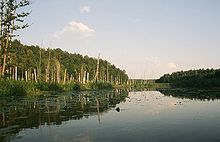Rospuda
| Rospuda | |
|---|---|

Rospuda between the Sumowo and Okrągłe lakes, nearby Kotowina village
|
|
| Country | Poland |
| Basin features | |
| Main source |
Czarne Lake 175 m (574 ft) |
| River mouth | Rospuda Augustowska Lake |
| Basin size | approx. 900 km2 (350 sq mi) |
| Physical characteristics | |
| Length | approx. 80 km (50 mi) |
| Discharge |
|
The Rospuda Polish pronunciation: [rɔsˈpuda] is a small river in north-eastern Poland. It flows through the Suwałki Region of Poland, including the north-western part of the large Augustów Primeval Forest wilderness area. Its continuation, the Netta, is a tributary of the Biebrza. Around 2006 the river was threatened by planned construction of the Augustów bypass expressway, which was to cut across the protected wilderness area in the valley. After an intense campaign of protests in Poland and abroad and also counter-protests of the local community, the plans have been changed, and now the highway has been rerouted to completely avoid the wilderness area.
Its usually quoted source is a combination of several streams, which rise on slopes of hills (Przejmowa Góra – 213.4m, Jastrzębia Góra – 230.8m, Słupowa Góra – 247.9 m, Lisia Góra – 259.5 m) southward of an old forest, Puszcza Romincka located southeast of Gołdap. The river proper rises from a lake called Jezioro Czarne and flows in a south and south-eastern direction through a series of nine postglacial lakes: Rospuda Filipowska, Kamienne, Długie, Garbas, Głębokie, Sumowo, Okrągłe, Bolesty, and The Rospuda Augustowska into which it finally empties. The Rospuda flows through typical young glacial landforms: postglacial channel lakes, eskers (long, narrow, winding ridges composed of stratified sand and gravel), and flat outwash plains. This landscape results from Scandinavian ice sheet activity during the Baltic glaciation: the postglacial channel in which the Rospuda flows was dug by a stream flowing underneath the ice sheet; eskers were composed of material accumulated by flowing water, and the outwash is a vast alluvial cone of sand and gravel deposited by a subglacial meltwater stream. In the upper reaches of the river, in the stretches between lakes, the Rospuda has a narrow winding channel of a rocky bed with rapids, for which it slightly resembles a mountain stream. The Rospuda flows through forests and meadows, within a narrow steep-sided valley with numerous bends, gorges, and felled trees. Narrow postglacial channel lakes flow for miles: Rospuda Filipowska and Bolesty, the longest two, are 3.6 mi (5.8 km) long and only 0.25–0.5 mi (0.40–0.80 km) wide. Their banks are high and forested or covered in meadows and cut across with ravines. These interesting landforms are attributable to erosion, the outcome of flowing rainwaters. In the lower reaches of the river, where it enters Augustów Primeval Forest, the Rospuda changes into a typically lowland river. It meanders through reeds within a boggy riparian valley, passing Święte Miejsce and Młyńsko, sacred sites in the region. The channel of the river gets wider forming a basin of peat bog, i.e. the Rospuda Valley (Pol. Dolina Rospudy).
...
Wikipedia
